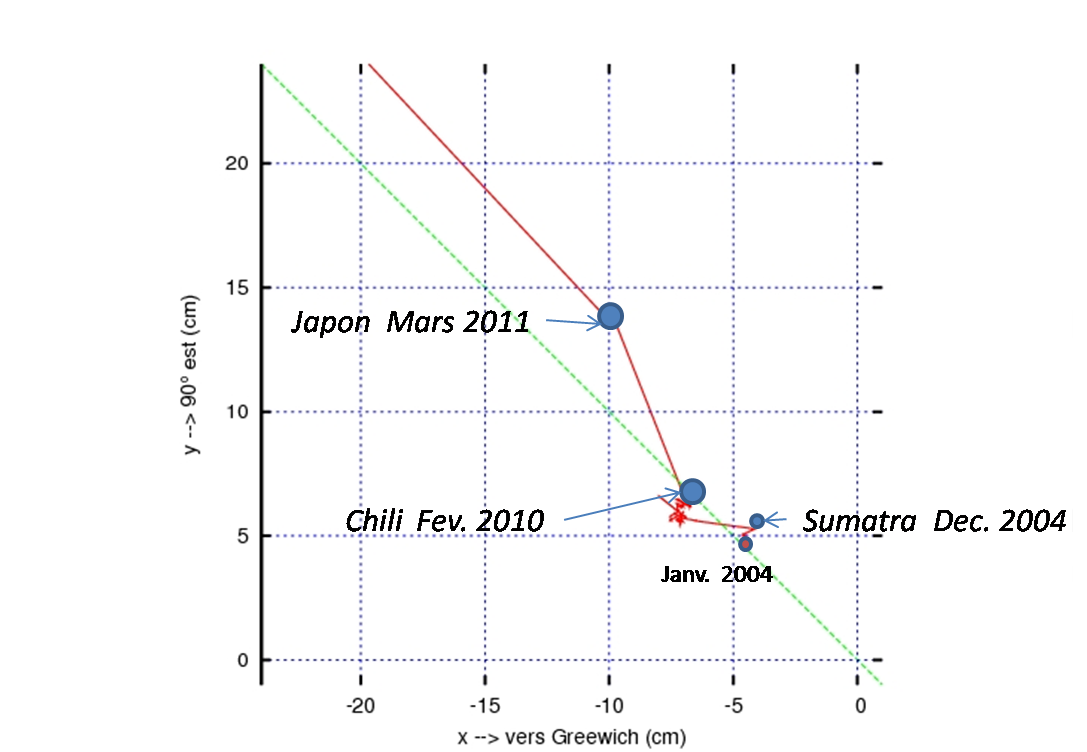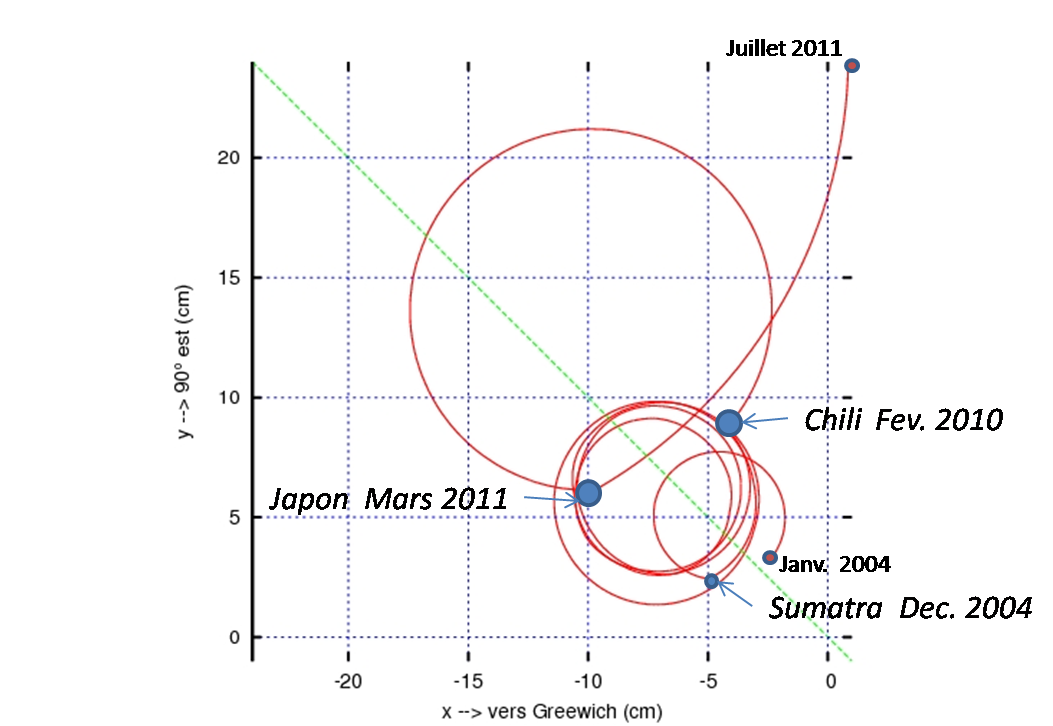  April 2016 : During the last winter many WEB tools have been improved, especially EOP analysis. Mean pole displacement obtained by Gaussian filter of IERS C01 combined pole coordinates series will be regularly updated: tabulated values x ("), y(") at 0.05 year interval since 1900 and plot. April 2016 : During the last winter many WEB tools have been improved, especially EOP analysis. Mean pole displacement obtained by Gaussian filter of IERS C01 combined pole coordinates series will be regularly updated: tabulated values x ("), y(") at 0.05 year interval since 1900 and plot.
 September 2015 : Christian Bizouard replaces Daniel Gambis at the head of the EOP-PC service. Retired from September 1 2015, Daniel Gambis remains active as scientific adviser. September 2015 : Christian Bizouard replaces Daniel Gambis at the head of the EOP-PC service. Retired from September 1 2015, Daniel Gambis remains active as scientific adviser.
 April 2012 : Spanish WEB page (under the supervision of Marta Folgueira) has been opened April 2012 : Spanish WEB page (under the supervision of Marta Folgueira) has been opened
 December 2011 : Only final values of the C04 EOP series values (that is Bulletin B values) are provided, in agreement with IERS mail 198. In consequence it stops 30 days back. For people inteterested in preliminary OPA (Observatoire de PAris) values till today, go there December 2011 : Only final values of the C04 EOP series values (that is Bulletin B values) are provided, in agreement with IERS mail 198. In consequence it stops 30 days back. For people inteterested in preliminary OPA (Observatoire de PAris) values till today, go there
 July 8, 2011 :Questionnaire on future of UTC July 8, 2011 :Questionnaire on future of UTC
 March 11, 2011 (updated on March 16): Our first estimates of the megaquake of Honshu, Nothern Japan Coast , at 5:46 UT on polar motion. According to the preliminary US Geological Survey and Harvard University seismic parameters used with Dahlen's dislocation model (1973), the principal axis of inertia
with highest moment of inertia (also called figure axis, closed to symetry axis) was displaced by about 15 cm at the earth surface in the direction 135° East (value confirmed by R. Gross, JPL, with another model). The effect is larger than for Chili (February 2010) and Sumatra (Dec. 2004) earthquakes (see below corresponding news). This could be observed as a step in the so-called excitation function, deduced from the determination of pole coordinates by space geodesy. But such a step could be hardly discernible from common hydro-meteorological processes. The oceanic angular momentum still lacking, only next months will tell us wether something is detectable.
March 11, 2011 (updated on March 16): Our first estimates of the megaquake of Honshu, Nothern Japan Coast , at 5:46 UT on polar motion. According to the preliminary US Geological Survey and Harvard University seismic parameters used with Dahlen's dislocation model (1973), the principal axis of inertia
with highest moment of inertia (also called figure axis, closed to symetry axis) was displaced by about 15 cm at the earth surface in the direction 135° East (value confirmed by R. Gross, JPL, with another model). The effect is larger than for Chili (February 2010) and Sumatra (Dec. 2004) earthquakes (see below corresponding news). This could be observed as a step in the so-called excitation function, deduced from the determination of pole coordinates by space geodesy. But such a step could be hardly discernible from common hydro-meteorological processes. The oceanic angular momentum still lacking, only next months will tell us wether something is detectable.
Modeled co-seismic shift of the main inertia pole since January 2004: Modeled co-seismic shift of the rotation pole since January 2004:
Modeled co-seismic shift of the rotation pole since January 2004:

C. Bizouard, S. Lambert, D. Gambis, J. Y. Richard, O. Becker. Service International de la Rotation de la Terre & Centre d'Analyse IVS
  February 2011: Implementation of the IERS 08 C04 system on 1 February 2011 February 2011: Implementation of the IERS 08 C04 system on 1 February 2011
The IERS has implemented the ITRF 2008 and made it available in its EOP products on 1 February 2011. The official IERS 08 C04 solution is available at ftp://hpiers.obspm.fr/iers/eop/eopc04 and the Rapid Service/Prediction Center solution is available at ftp://maia.usno.navy.mil/ser7/. Users are advised to update their data from these sites on 1 February to ensure that they are fully consistent with the new 08 C04 system. The former 05 C04 solution will be stopped on June 2011.
D. Gambis, C. Bizouard, Earth Orientation Center, Paris Observatory
B. Luzum, N. Stamatakos, IERS Rapid Service/Predictions Center,
 March 2010 : The Chile Earthquake of February 27th, 2010 of magnitude 8.8 has caused no DETECTABLE effect on the rotation pole and rotation rate. Independently of Earthquake, rotation pole moves of some mm up to several cm per day because of continuous atmospheric, oceanic and hydrologic mass transport. Till now the effect of Earthquake remains a theoretical matter. According to the seismic models, the recent Chile event will have the effect of disturbing the rotation pole by 8 cm in some months, small amount in comparison with the path a few meters it will achieve during this period. By handling atmospheric, oceanic and hydrologic data, this path will be modelled with a mean error of 50 cm, so that the tiny seismic effect will probably remain undiscernible. The Chile earthquake, would also have decrease the length of day, as high as 2 microseconds, that is to say below the current error on this quantity (10 microseconds), and much lower than the daily variation sometimes coming to 50 microseconds, and mainly caused by winds. March 2010 : The Chile Earthquake of February 27th, 2010 of magnitude 8.8 has caused no DETECTABLE effect on the rotation pole and rotation rate. Independently of Earthquake, rotation pole moves of some mm up to several cm per day because of continuous atmospheric, oceanic and hydrologic mass transport. Till now the effect of Earthquake remains a theoretical matter. According to the seismic models, the recent Chile event will have the effect of disturbing the rotation pole by 8 cm in some months, small amount in comparison with the path a few meters it will achieve during this period. By handling atmospheric, oceanic and hydrologic data, this path will be modelled with a mean error of 50 cm, so that the tiny seismic effect will probably remain undiscernible. The Chile earthquake, would also have decrease the length of day, as high as 2 microseconds, that is to say below the current error on this quantity (10 microseconds), and much lower than the daily variation sometimes coming to 50 microseconds, and mainly caused by winds.
Alone a mega-seism, such that of Chile in 1960, could cause a visible effect with the modern geodetic techniques.
 March 2009 : WEB tool generating tidal variations in LOD, UT1 and Earth angular velocity. March 2009 : WEB tool generating tidal variations in LOD, UT1 and Earth angular velocity.
 February
2009 : Many improvements have been brought on the site. See in particular
the comparison C04 - individual EOP. We propose a new version of Bulletin B, available on ftp://hpiers.obspm.fr/iers/bul/bulb_new/. February
2009 : Many improvements have been brought on the site. See in particular
the comparison C04 - individual EOP. We propose a new version of Bulletin B, available on ftp://hpiers.obspm.fr/iers/bul/bulb_new/.
 November 2007
: WEB Service has been opened. We provide two executables (Linux/DOS)
to be called in any procedure (Fortran/C/php/Perl) : i) download of EOP
C04 parameter at a given date ; ii) the computation of the Earth Orientation
matrix (between ITRF and ICRF) at any instant. November 2007
: WEB Service has been opened. We provide two executables (Linux/DOS)
to be called in any procedure (Fortran/C/php/Perl) : i) download of EOP
C04 parameter at a given date ; ii) the computation of the Earth Orientation
matrix (between ITRF and ICRF) at any instant.
 Summer 2007 :
the WEB site has been updated : analysis / comparison of EOP series
(all VLBI series are given with the celestial pole offsets dX, dY referred
to IAU 2000 model) ; interactive
analysis of the excitation takes now into account the oceanic forcing
(ECCO model). Summer 2007 :
the WEB site has been updated : analysis / comparison of EOP series
(all VLBI series are given with the celestial pole offsets dX, dY referred
to IAU 2000 model) ; interactive
analysis of the excitation takes now into account the oceanic forcing
(ECCO model).
 June 2006 :
EOPC04 : IMPROVED VERSION CONSISTENT WITH ITRF June 2006 :
EOPC04 : IMPROVED VERSION CONSISTENT WITH ITRF
 December 2005 :
EOPC04 : IMPROVED / EXPERIMENTAL VERSION December 2005 :
EOPC04 : IMPROVED / EXPERIMENTAL VERSION
 October 2005 : The atmospheric excitation of the Polar motion and lenght-of-day is available up to the last week. October 2005 : The atmospheric excitation of the Polar motion and lenght-of-day is available up to the last week.
 July 2005 : The Earth orientation Center at the Paris Observatory has decided to introduce
a leap second on 31 december
2005, 23h59min59s UTC. No leap second was added during the last 6 years,
since 31 december 1998, because of strong decadal acceleration of the Earth
rotation (which seems presently to be over). July 2005 : The Earth orientation Center at the Paris Observatory has decided to introduce
a leap second on 31 december
2005, 23h59min59s UTC. No leap second was added during the last 6 years,
since 31 december 1998, because of strong decadal acceleration of the Earth
rotation (which seems presently to be over).
 February 2005 : February 2005 :
Daniel
Gambis comments on Sumatra Earthquake
The official ILRS
combined EOP solution (avaible on our WEB/FTP site) derived by ASI
from 5 individual solutions (ASI, DGFI, GFZ, JCET and NSGF) is replacing
the individual SLR solutions in the EOP-PC analyses. According to this
series, there is a noticable jump in y-component of the polar motion for
the day of the Sumatra Earthquake.
 January 2005
: EOP operational series can be selected,
drawn and submitted to numerical analysis January 2005
: EOP operational series can be selected,
drawn and submitted to numerical analysis
 December 2004
: According to theoretical modeling of Dahlen (1973) and Harvard
seismic moment tensor solution, the rotation axis would have undergo 0.5-1
milliarcsecond shift towards Pacific in a few minutes because of the Sumatra
Earthquake (computation done by Ch. Bizouard). Because of the weak
time resolution of Earth orientation parameters, it cannot be distinguished
easily from other geophysical influence, which cause pole motion with
the rate 1-3 mas/day. At the date of 1/1/2005 GPS determination of the
polar motion did not allow us to prove any Earthquake effect. Wait and
see. December 2004
: According to theoretical modeling of Dahlen (1973) and Harvard
seismic moment tensor solution, the rotation axis would have undergo 0.5-1
milliarcsecond shift towards Pacific in a few minutes because of the Sumatra
Earthquake (computation done by Ch. Bizouard). Because of the weak
time resolution of Earth orientation parameters, it cannot be distinguished
easily from other geophysical influence, which cause pole motion with
the rate 1-3 mas/day. At the date of 1/1/2005 GPS determination of the
polar motion did not allow us to prove any Earthquake effect. Wait and
see.
 June 2004
: After a severe breakdown, the system has been updated. June 2004
: After a severe breakdown, the system has been updated.
 November
2003 : Interactive
comparison of the EOP series November
2003 : Interactive
comparison of the EOP series
 October 2003
: Time
series of the Earth orientation matrix / precession-nutation matrix /
instantaneous rotation vector October 2003
: Time
series of the Earth orientation matrix / precession-nutation matrix /
instantaneous rotation vector
 September 2003 :Interactive
Analysis of the EOP (FFT, least-square estimates, filtering) September 2003 :Interactive
Analysis of the EOP (FFT, least-square estimates, filtering)
 July
2003 : Atmospheric excitation of the nutation (interactive tool) July
2003 : Atmospheric excitation of the nutation (interactive tool)
 June 2003 : Excitation
functions of the Polar motion and lenght-of-day (interactive tool) June 2003 : Excitation
functions of the Polar motion and lenght-of-day (interactive tool)
 Mai 2003 : Rotation
matrix from the international terrestrial reference frame to the international
celestial reference frame, UT1-UTC real time on line (see home page) Mai 2003 : Rotation
matrix from the international terrestrial reference frame to the international
celestial reference frame, UT1-UTC real time on line (see home page)
 April
2003 : Interactive
tool for the selection of EOP parameters and their plots (series C04
and C01). April
2003 : Interactive
tool for the selection of EOP parameters and their plots (series C04
and C01).
 April 2003 :
Table of the available EOP
on this server (combined, operational, long term) April 2003 :
Table of the available EOP
on this server (combined, operational, long term)
 January
2003 : As the IERS follows the conventions UAI 2000 from the 1/1/2003,
changes have been introduced in our products. We provide alternative
C04 series where the celestial pole offsets are given with respect to
the UAI 2000 nutation model by the parameter (dX,dY) January
2003 : As the IERS follows the conventions UAI 2000 from the 1/1/2003,
changes have been introduced in our products. We provide alternative
C04 series where the celestial pole offsets are given with respect to
the UAI 2000 nutation model by the parameter (dX,dY)
 November 2002 : The
interpolation of PM and UT1 in order to include diurnal and semidiurnal
periods is done now by 71 oceanic tidal waves and 10 lunisolar terms (1
mas accuracy) (conventions IERS 2000) : revised
version of the subroutine interp.f November 2002 : The
interpolation of PM and UT1 in order to include diurnal and semidiurnal
periods is done now by 71 oceanic tidal waves and 10 lunisolar terms (1
mas accuracy) (conventions IERS 2000) : revised
version of the subroutine interp.f
 September
2002 :UTC Questionnaire results are available. September
2002 :UTC Questionnaire results are available.
 May 2002 :EOP
series from DORIS technique are available
there. May 2002 :EOP
series from DORIS technique are available
there.
 November 2001 : Introduction of useful constants table. November 2001 : Introduction of useful constants table.
 October 2001 : Introduction of plots: individuals SLR series compared to C04 for
X-pole and Y-pole. October 2001 : Introduction of plots: individuals SLR series compared to C04 for
X-pole and Y-pole.
 June 2001 :
A new section proposes
the individual EOP series. These are the series for the Annual Report 2001. June 2001 :
A new section proposes
the individual EOP series. These are the series for the Annual Report 2001.
 April 2001 :New
graphics are available on the site. They show comparaisons between C04 series
and those of 4 VLBI analysis centers (BKG, GSFC, IAA and SPBU) on
X-pole, Y-pole, UT1, UT1 intensives, dPsi, dEps. April 2001 :New
graphics are available on the site. They show comparaisons between C04 series
and those of 4 VLBI analysis centers (BKG, GSFC, IAA and SPBU) on
X-pole, Y-pole, UT1, UT1 intensives, dPsi, dEps.
 April 2001 :
The C04 is available in
1 file since 1962 until now. April 2001 :
The C04 is available in
1 file since 1962 until now.
 April 2001 :
The IERS web site is available in french. April 2001 :
The IERS web site is available in french.
 March 2001 :
The polar motion graphic with 100 days prediction, up-dated twice a week,
is now available. March 2001 :
The polar motion graphic with 100 days prediction, up-dated twice a week,
is now available.
 February 2001 : A new section is now available and proposes all the operationals series
that the IERS EOP-PC receives. These series are updated twice a week. February 2001 : A new section is now available and proposes all the operationals series
that the IERS EOP-PC receives. These series are updated twice a week.
 February 2001 : A new IERS format
was proposed to standardize the format of differents techniques (GPS, VLBI,
LLR, SLR,DORIS). February 2001 : A new IERS format
was proposed to standardize the format of differents techniques (GPS, VLBI,
LLR, SLR,DORIS).
 1 February 2001 : The IERS EOP-PC (EOP-PC), located at the Paris Observatory, has opened
a web page. 1 February 2001 : The IERS EOP-PC (EOP-PC), located at the Paris Observatory, has opened
a web page.
|




